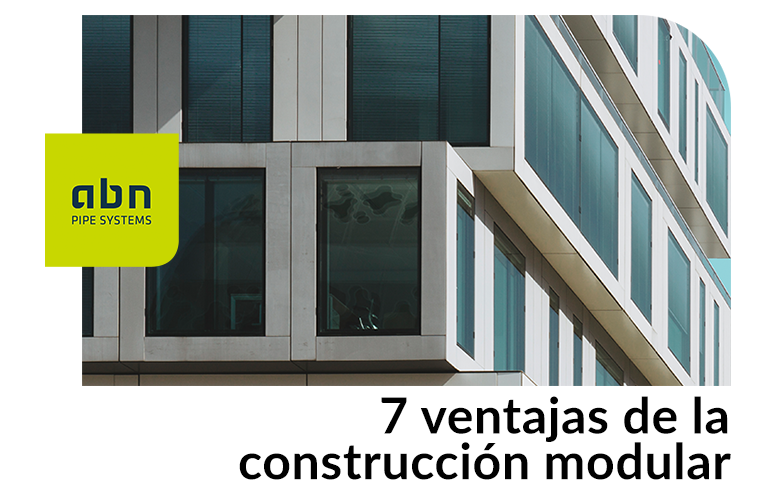En los últimos años, el sector de la construcción ha cambiado de manera radical; ha evolucionado hasta adaptarse a los nuevos avances sociales y tecnológicos, dejando atrás las técnicas de construcción tradicionales.
En este nuevo escenario en el que la inmediatez, la versatilidad y la sostenibilidad son atributos clave en una obra, una de las tendencias que ha surgido con más fuerza es la construcción modular.
¿Qué es la construcción modular?
La construcción modular, también conocida como construcción prefabricada, implica la fabricación de componentes de un edificio en una ubicación lejos de su espacio de construcción definitivo y su posterior traslado e instalación en el lugar final.
Estos componentes, o módulos, están diseñados y fabricados bajo condiciones controladas, lo que garantiza una alta calidad y precisión en la construcción.
Las casas modulares favorecen la flexibilidad y personalización de la edificación a proyectar y se convierten en una alternativa a la situación actual de edificación masiva, a costes elevados y tiempos lentos.
Estructuralmente, los edificios modulares son generalmente más resistentes que las construcciones tradicionales porque cada módulo está independientemente desarrollado para soportar los rigores del transporte y las labores de grúa sobre los cimientos.
Los materiales que se utilizan para su elaboración son variados. Los más comunes son el hormigón, la madera y el acero. No obstante, también existen casas modulares fabricadas con otro tipo de materiales, como la piedra y la pizarra.
Ventajas de las edificaciones modulares
A continuación, enumeramos algunas de las múltiples ventajas de la construcción modular:
1. Mayor rapidez y optimización de los tiempos
Los tiempos de ejecución son mucho más cortos que en una construcción tradicional. Según distintos estudios, se puede ahorrar de media un 50% en los plazos de finalización de una vivienda prefabricada con respecto a la construcción convencional.
Además, como se construye por módulos, el proceso de acondicionamiento interior se produce de manera paralela al ensamblaje.
2. Ahorro de costes
Al reducir los tiempos de ejecución, se reducen también los costes. El precio medio de estas construcciones está entre 800 y 1.000 euros el metro cuadrado, mientras que las tradicionales oscilan entre los 1.300 y 1.600, sobre todo por la estandarización de sus procesos y producción a gran escala.
Además, el precio suele cerrarse antes de la compra, sin imprevistos, ni incrementos de costes.
3. Calidad y precisión
La construcción en fábrica permite un control de calidad riguroso, ya que cada módulo se construye bajo condiciones controladas y se somete a estrictas inspecciones antes de ser transportado al sitio.
Y ese control se realiza no solo de los módulos finales en sí, sino también de cada uno de los elementos que conforman una pieza concreta.
Tanto la fabricación como el ensamblaje de los materiales están mucho más controlados y eso repercute en la calidad final.
4. Eficiencia energética
Estas nuevas construcciones incluyen las últimas innovaciones y certificados de eficiencia energética, lo que implica un importante ahorro energético.
La mayoría de los edificios modulares están hechos de hormigón armado, que es un excelente aislante. Algunos incluso combinan el hormigón con el poliestireno expandido, que también influye en el aislamiento térmico de las viviendas.
Precisamente ese excelente aislamiento incide directamente en el ahorro energético de las viviendas. La casa requerirá menos uso de sistemas de aerotermia y eso se notará en la factura de la luz y en la contaminación que produzca.
5. Reducción del impacto ambiental
La realización de los módulos en fábrica reduce considerablemente la cantidad de residuos que se producen en obra, ya que las piezas que se envían a la parcela en sí vienen casi terminadas. Además, se controla mucho más el proceso en fábrica, reduciendo el desperdicio de materiales y fomentando su reciclaje.
En el momento de su construcción es más fácil añadir sistemas de energía alternativas, de reciclado de agua, etc. También se reduce la contaminación del agua y el polvo, así como el impacto acústico.
6. Adaptabilidad y escalabilidad
Al configurarse con módulos ensamblados, tienen siempre la oportunidad de crecer en el momento que sea necesario pudiendo optar a mejoras y avances.
7. Personalización y flexibilidad del diseño
No está limitada por los métodos de construcción tradicionales, lo que significa que los diseños pueden ser más creativos y personalizados según las necesidades del cliente y su presupuesto.
La metodología BIM para la instalación de sistemas de tuberías en construcciones modulares
La ventaja clave de la metodología BIM en construcción prefabricada es su capacidad para facilitar la colaboración entre equipos multidisciplinarios. Esto fomenta una mayor eficiencia en la toma de decisiones y un mejor control sobre los costos y plazos de ejecución.
En el caso de los sistemas de tuberías, un factor clave de éxito para una instalación es crear una metodología de trabajo, desarrollando el plan de acción con anticipación y siguiéndolo de manera precisa, sin olvidar que es prioritario que el sistema modular sea adaptable.
El desarrollo de un sistema de tuberías prefabricadas requiere de un flujo permanente de información entre todos los que intervienen en el proyecto: fabricante, contratista principal e ingeniería, siempre con la propiedad informada, por lo que el uso de la metodología BIM es fundamental al garantizar la comunicación entre todas las partes del proyecto independientemente del software que utilice cada uno de los implicados.

Estos factores hacen que la construcción modular sea mucho más que una tendencia. Su capacidad para combinar eficiencia, sostenibilidad y flexibilidad la convierte en una opción atractiva para una amplia gama de proyectos.
A medida que la tecnología y las técnicas de construcción modular continúen evolucionando, podemos esperar un futuro en el que esta forma de construcción sea la norma en lugar de la excepción.
